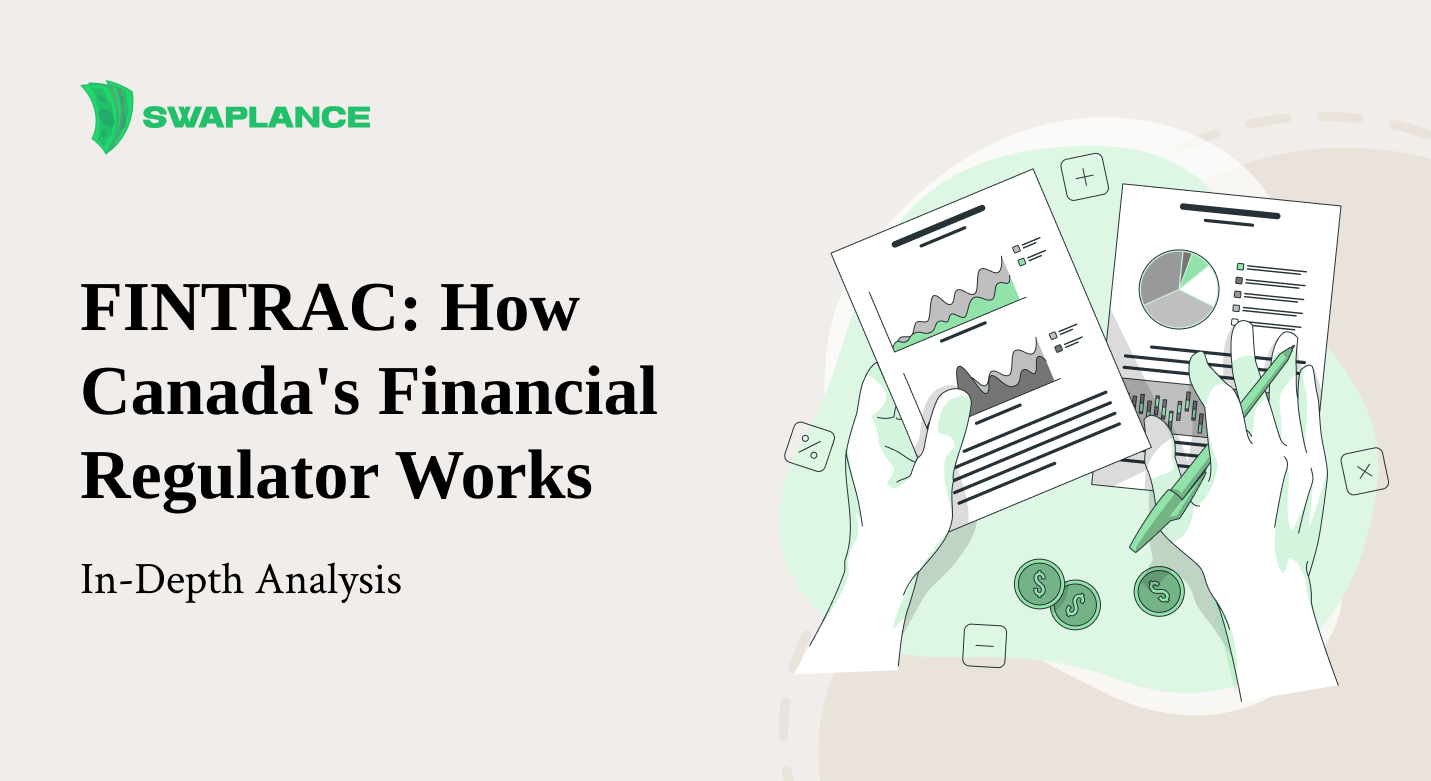
FINTRAC: How Canada's Financial Regulator Works
Canada’s financial sector is one of the most highly regulated in the world, ensuring that transactions are conducted safely and lawfully. A major player in this regulatory landscape is the Financial Transactions and Reports Analysis Centre of Canada, commonly known as FINTRAC. This agency is vital in monitoring financial transactions to prevent money laundering, terrorist financing, and other illicit activities. In this article, we’ll explore what FINTRAC is, how it functions, and why its presence is crucial for Canadian businesses.
What Is FINTRAC?
What is FINTRAC, and why is it important? FINTRAC stands for the Financial Transactions and Reports Analysis Centre of Canada, a federal agency established in 2000 under the Proceeds of Crime (Money Laundering) and Terrorist Financing Act (PCMLTFA). The agency's primary purpose is to detect, prevent, and deter money laundering and the financing of terrorist activities. As a financial intelligence unit (FIU), FINTRAC collects and analyzes information on financial transactions and works closely with other national and international organizations to combat financial crimes.
FINTRAC’s mandate extends beyond merely observing suspicious transactions. The agency collaborates with law enforcement, regulatory bodies, and international FIUs to share intelligence and protect the integrity of Canada’s financial system. In addition to preventing financial crimes, FINTRAC also ensures that Canada complies with global anti-money laundering (AML) and anti-terrorism financing standards, particularly those set by the Financial Action Task Force (FATF).
How FINTRAC Works
To understand what does FINTRAC do and how does FINTRAC work, it’s helpful to look at the organization’s operational framework. FINTRAC operates as Canada’s financial intelligence unit, analyzing data and identifying patterns in financial transactions that might indicate illegal activities. Here’s a closer look at the core activities that define FINTRAC’s operations:
- Data Collection and Reporting: FINTRAC receives information from businesses and individuals who are legally required to report specific types of financial transactions. This includes large cash transactions (over CAD 10,000), electronic funds transfers, and suspicious transactions. Financial institutions, real estate brokers, and even casinos are among the entities mandated to report transactions to FINTRAC.
- Data Analysis: Once FINTRAC collects data, its experts analyze the information to identify patterns or anomalies. These could be indications of money laundering schemes or suspicious financial behavior that could be linked to criminal activities. Advanced data analytics tools help FINTRAC detect unusual patterns in the financial system. For businesses, having experienced compliance consultants from Swaplance can streamline the process of setting up appropriate AML measures and maintaining transparency.
- Dissemination of Intelligence: If FINTRAC identifies any transactions or trends that raise red flags, it shares this intelligence with law enforcement agencies, such as the Royal Canadian Mounted Police (RCMP), Canada Border Services Agency (CBSA), and other relevant authorities. While FINTRAC cannot initiate legal action, it can provide intelligence to aid in investigations.
- Compliance and Enforcement: FINTRAC also ensures compliance with Canada’s AML and anti-terrorist financing laws. The agency conducts regular audits and investigations of reporting entities to verify that they follow appropriate protocols. When a business fails to comply, FINTRAC can impose administrative monetary penalties (AMPs) or refer cases to law enforcement.
By carrying out these activities, FINTRAC helps maintain transparency in Canada’s financial system and ensures that financial institutions remain vigilant against potential risks.
FINTRAC’s Role in Canada
To grasp what is FINTRAC in Canada, it’s essential to understand the agency's place within the country's regulatory framework. FINTRAC Canada serves as a key institution in enforcing financial transparency, working to protect the economy from being exploited by criminals. The agency’s primary role is to detect and deter money laundering, terrorist financing, and other financial crimes. Here’s a breakdown of its main roles in Canada:
- Protecting National Security: By identifying and tracking financial activities linked to criminal organizations or terrorist groups, FINTRAC plays an active role in safeguarding Canada’s national security. The agency’s intelligence gathering helps law enforcement detect threats before they manifest into more severe incidents.
- Promoting Financial Integrity: FINTRAC helps ensure that Canada’s financial system is fair, transparent, and reliable. By enforcing AML and anti-terrorism financing regulations, the agency prevents criminals from using Canadian institutions for illicit purposes, thereby protecting the financial system's integrity.
- Facilitating International Cooperation: FINTRAC collaborates with financial intelligence units and regulatory bodies worldwide to combat global financial crimes. Given the cross-border nature of money laundering and terrorist financing, FINTRAC’s cooperation with international partners is crucial for maintaining global financial security.
- Ensuring Compliance with Global Standards: Canada is a member of the FATF, an intergovernmental body that sets international standards for combating money laundering and terrorist financing. FINTRAC helps Canada meet its FATF obligations by enforcing rigorous compliance measures for financial institutions and other reporting entities. By adhering to these standards, FINTRAC helps Canada maintain its reputation as a safe and lawful environment for international business.
Through these roles, FINTRAC Canada demonstrates its dedication to promoting a transparent financial landscape, both domestically and internationally.
Why FINTRAC Is Important for Businesses
For businesses in Canada, understanding what does FINTRAC do and why FINTRAC is important for businesses is essential. Compliance with FINTRAC regulations is not only a legal requirement but also a critical step in fostering trust and transparency in the financial sector. Here are some reasons why FINTRAC is important for Canadian businesses:
- Legal Compliance and Avoiding Penalties: Canadian businesses, particularly those in the financial sector, must comply with FINTRAC regulations to avoid significant penalties. Failure to report suspicious transactions or maintain proper AML practices can result in steep fines and reputational damage. By adhering to FINTRAC’s guidelines, businesses avoid these risks and demonstrate their commitment to operating lawfully.
- Enhanced Customer Trust: In today’s globalized financial environment, customers are increasingly cautious about fraud and money laundering risks. Businesses that comply with FINTRAC’s standards reassure customers that their transactions are being handled by an organization dedicated to integrity and safety. This trust can enhance customer relationships and build long-term loyalty.
- Improved Risk Management: Compliance with FINTRAC regulations helps businesses establish robust risk management frameworks. By identifying and mitigating potential financial crimes early, businesses can protect themselves from threats that could harm their operations and bottom line. This proactive approach to risk management is vital for businesses that operate in high-risk industries or deal with international transactions.
- Contributing to National Security: By following FINTRAC’s AML and anti-terrorism financing regulations, businesses contribute to Canada’s national security efforts. This collective effort helps prevent criminals from using Canadian institutions for illicit activities, protecting the broader economy and the public.
FINTRAC’s role in setting AML and compliance standards for businesses has far-reaching benefits. It encourages best practices in financial management, promotes transparency, and helps businesses operate responsibly within Canada’s regulated economy.
Conclusion
FINTRAC plays a pivotal role in protecting Canada’s financial system from criminal exploitation, supporting national security, and promoting transparency within the financial sector. As Canada’s financial intelligence unit, FINTRAC’s work involves collecting and analyzing data, providing intelligence to law enforcement, and ensuring compliance with national and international regulations.
For Canadian businesses, compliance with FINTRAC’s requirements is essential. Adhering to FINTRAC regulations not only protects businesses from legal penalties but also enhances customer trust, strengthens risk management, and contributes to national security. By understanding what is FINTRAC in Canada, business owners can appreciate its importance in maintaining a fair, transparent, and lawful financial environment. In a world where financial crime is increasingly complex, FINTRAC’s role in Canada is more critical than ever.
Common questions
-
What are the main responsibilities of FINTRAC in regulating financial transactions in Canada?FINTRAC’s main responsibilities in regulating financial transactions in Canada include monitoring and analyzing financial data to detect and prevent money laundering, terrorist financing, and other illicit activities. As Canada's financial intelligence unit, FINTRAC collects transaction reports from businesses across various sectors, such as banks, real estate firms, and casinos, which are legally required to report specific types of transactions. The agency uses this information to identify suspicious financial patterns and then shares its findings with law enforcement and international partners to support criminal investigations. FINTRAC’s work helps protect Canada’s financial system and maintains transparency and integrity within the economy.
-
How does FINTRAC collaborate with financial institutions to prevent money laundering and fraud?FINTRAC collaborates closely with financial institutions to prevent money laundering and fraud by setting regulatory requirements and ensuring compliance through reporting and monitoring activities. Financial institutions are required to report suspicious transactions, large cash transactions, and electronic funds transfers that meet certain thresholds. FINTRAC analyzes these reports and uses them to detect patterns indicative of financial crimes, which it then shares with law enforcement agencies. Additionally, FINTRAC provides guidelines and resources to help institutions strengthen their anti-money laundering (AML) and fraud prevention measures, creating a collaborative effort to protect Canada’s financial ecosystem.
-
What impact does FINTRAC's oversight have on the compliance practices of Canadian businesses?FINTRAC's oversight significantly influences the compliance practices of Canadian businesses, especially those in financial sectors like banking, insurance, and currency exchange. Under FINTRAC regulations, businesses are required to implement strict anti-money laundering (AML) and anti-terrorist financing measures, which include verifying customer identities, monitoring transactions, and reporting suspicious activities. This oversight encourages companies to establish comprehensive compliance programs, increasing their operational transparency and accountability. While compliance can involve additional costs and procedural complexity, it helps businesses avoid legal penalties, builds consumer trust, and strengthens the integrity of Canada’s financial system.
 Mark Petrenko
Mark Petrenko 




